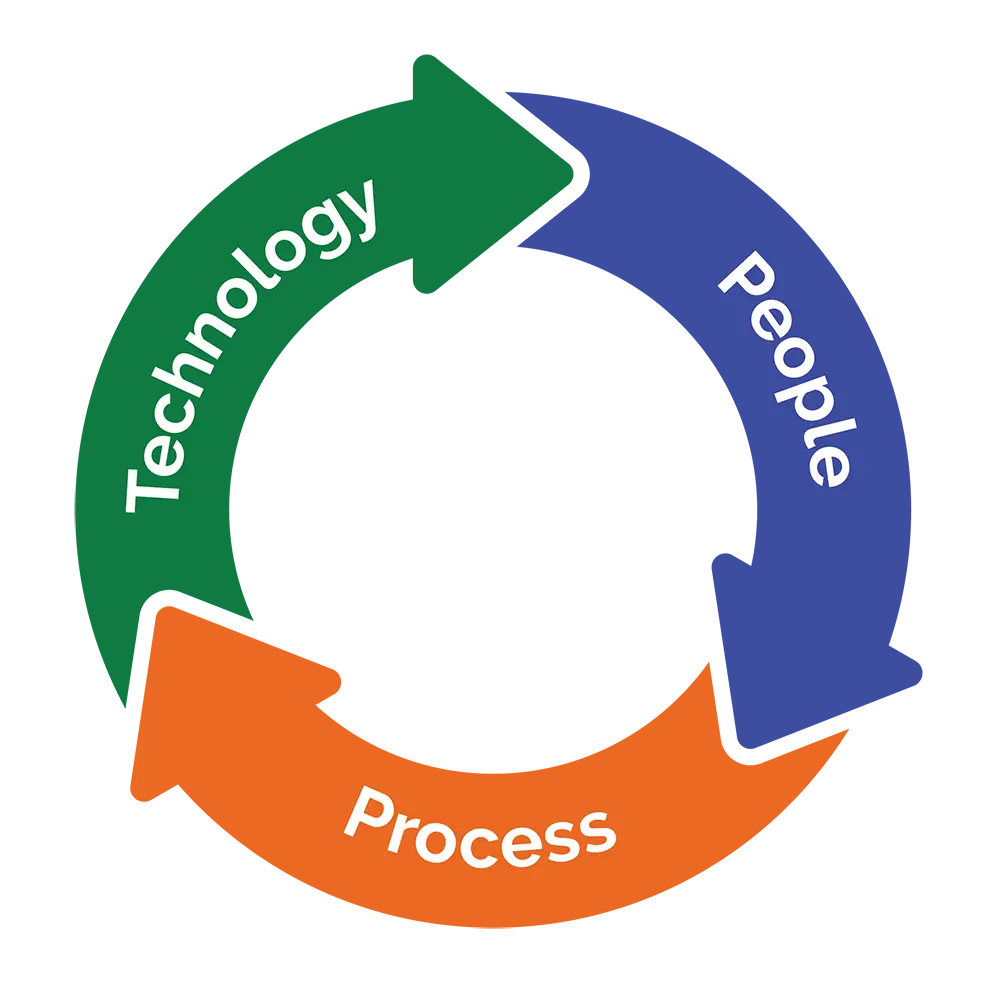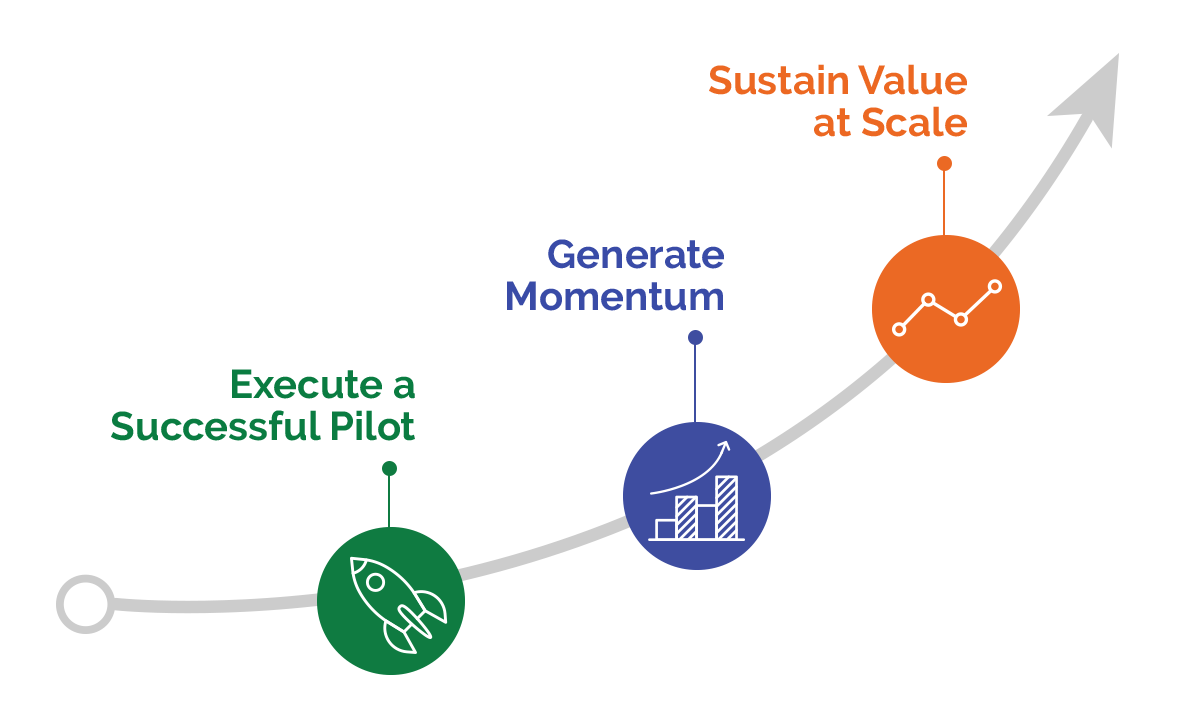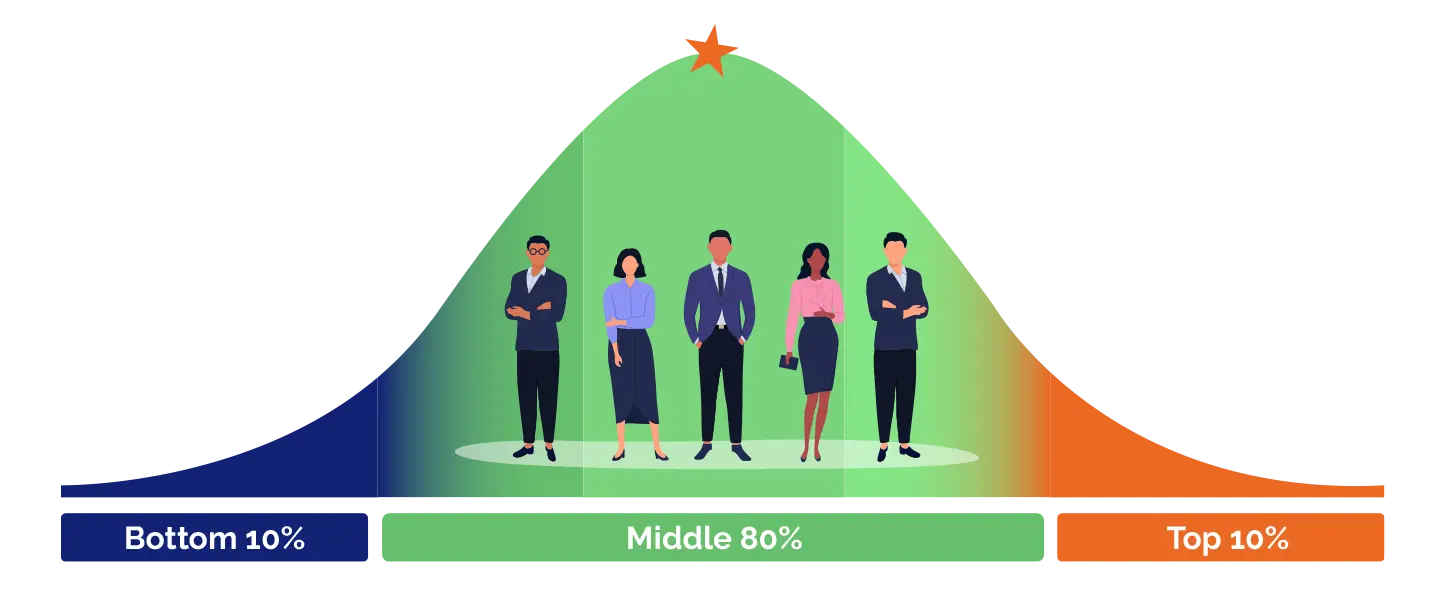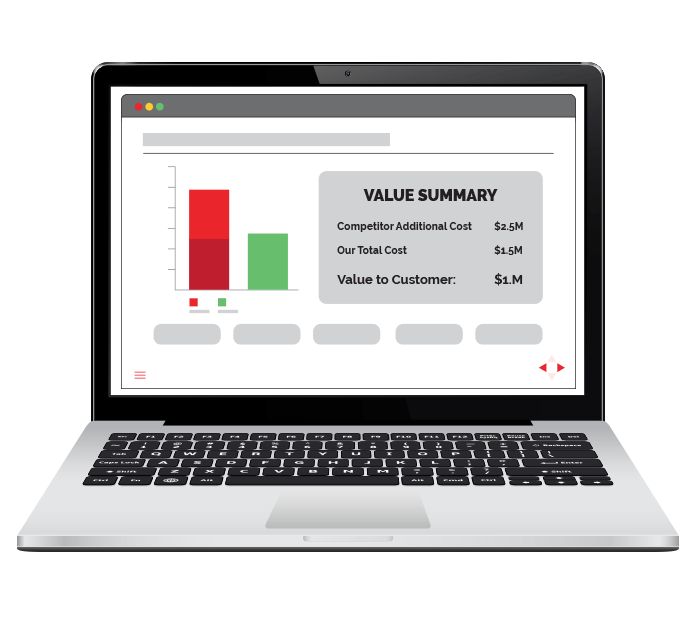What is Value-Based Selling
Value Selling has been used by leading B2B organizations for decades to win and retain business on the basis of superior customer value delivered. By quantifying this value, presenting a business case to buy, and making it central to sales and customer conversations, your sales team will be laser-focused on the financial outcomes that matter most to the customer.
This focus helps to qualify accounts better, moving buyers through their journey with a clearer understanding of what you deliver and how you are different. The result is increased sales, higher prices, and faster sales cycles.
Selling Value Over Price: The Impact
Value selling helps sales teams boost their sales results and bottom-line profitability by increasing sales velocity. By measuring how quickly deals successfully move through the pipeline, the sales velocity formula shows how different factors impact revenue growth.
Unlike most sales methodologies and tools, value selling impacts all four sales velocity levers:
- Increase the Number of Qualified Opportunities
- Increase the Average Deal Value
- Increase the Win Rate
- Reduce Average Sales Cycle Time


Let’s explore each in more detail:
- Increase the Number of Qualified Opportunities: A good value selling process will serve as a means to quickly qualify deals in or out. According to Corporate Visions, 60% of B2B opportunities in a typical pipeline are not lost to the competition, but rather “no decision.” At the same time, only 22% of buyers think that vendor sales reps understand their issues. Value propositions support better call prep, and provide key content reps need reps need to engage decision makers. If a prospect does not respond to value they can realize, the prospect is probably not qualified. Reps, using value conversations to qualify targets, spend more time on deals that actually close. For these opportunities, they will be armed with the content and techniques to engage sponsors and move deals forward.

- Increase the Average Deal Value: Value selling means jointly developing a business case to buy with the customer or prospect. A well-designed value story will provide internal justification, defend against discounting pressure, and build buyer confidence in a larger, more comprehensive solution throughout the sales process. Distilling sales conversations into financial terms reduces buyer confusion that causes up to 80% of purchasers to choose smaller and less disruptive solutions. LeveragePoint customers report seeing a boost in average deal value ranging from 5-25%.

- Increase the Win Rate: By centering every opportunity on the prospect’s business case to buy, B2B sales teams engage in value conversations that give them a leg up over the competition. According to Forrester, the first vendor to succeed in communicating a vision of value to executives wins the business 74% of the time. Key to this is using value selling to continue this value narrative across the buyer’s journey. LeveragePoint customers report win rate increases from 5-15% using our software to support their value selling efforts.

- Reduce the Length of Sales Cycles: Value selling helps focus sales conversations on financial outcomes, instead of getting bogged down in feature and specification discussions. The best way for B2B sales people to overcome increasingly longer sales cycles, is to adopt the approach of the best sales reps, who spend 52% more time talking about value-related subjects than average performers.
Value Selling Methodology
Let’s return to the definition of value selling, and zoom in on a few key components:
Value selling is a sales approach that centers sales conversations on the economic impact your offering delivers to your customer.
Let’s review the key components in reverse order:
- A differentiated offering or solution: Value selling forces commercial teams to assess their solution for the differentiated benefits it provides to the customer. In a good value story, this differentiation drives clear financial value drivers, such as time savings, cost savings, or improved throughput/efficiency, but can also include harder-to-measure impacts, such as sustainability and brand impacts. Strong value management practices ensure the development, offer design, and packaging of solution sets that provide this value. Strong value selling communicates this value effectively.
- Quantified economic impact: Once the economic impact of a differentiated offering is identified, it can be quantified based on a simple understanding of the customer’s business. Tailoring quantified value for customer-specific circumstances to every sales opportunity becomes a productive sales habit. It is not hard to discover and incorporate a buyer’s business data into a quantified value proposition that becomes a specific business case to buy that is unique to them. This business case unlocks access to decisionmakers, and puts opportunities on the fast-track to approval.
- High quality customer conversations: The very process of developing a custom business case is of equal importance to the business case itself. Interactivity is key. Salespeople collaborate with a buyer by presenting reasonable estimates of value delivered, inviting the buyer to refine or agree with specific details, creating a shared sense of ownership. By engaging in two-way value conversations, customer value becomes the focus, rather than features, specifications, or price. The resulting content becomes a shared business case to buy, giving sellers and sponsors leverage in pushing deals through purchasing processes.
This definition of value selling goes beyond less specific, alternative meanings widely used in B2B. At LeveragePoint, we believe that value selling is more than just:
- Prioritizing customer needs during the sales process.
Customer-centricity is a central tenet of value selling. Prioritizing only identified customer needs may miss important unrecognized customer problems. A good value proposition is aligned with Challenger Sale methodology, teaching differentiation, reframing an unrecognized problem in order to provide a new framework for addressing it.
Going beyond identified qualitative customer needs to value selling elevates the conversation to a more important topic: specific financial outcomes your solution delivers. By focusing conversations on financial value, value selling helps salespeople address identified customer needs while it generates those “aha moments” where a customer realizes your team has a solution to a previously unrecognized problem.
- Salespeople “adding value” in every customer touchpoint.
Adding value in every meeting is a necessary, but not sufficient, way to approach value selling. Oftentimes, this “value” is defined down to educating the customer about things like your solution set, the competitive landscape, new features, or what other, similar firms are doing. While these are useful building blocks for a sales conversation, a successful value selling conversation requires the sales representative to communicate outcomes in customer-specific, financial terms.
- Another sales training methodology.
Leading sales methodologies, such as Challenger, Insight, Consultative and Solution selling, take different approaches to the political and analytical nature of B2B sales. There are, however, three major central value-selling themes that are identifiable elements of each of these methodologies:
○ Customer Centricity – the most effective sales conversations are the ones focused on the buyer’s specific problems and/or objectives.
○ Customer Relevant Content – the most impactful sales content is, at a minimum, relevant to the customer’s business/industry, and ideally is customized to the account and its individual stakeholders.
○ Outcome Focused Approach – sales must address the internal accountability a customer sponsor bears for the success of the buying decision – agreeing a clear picture of success together with hard outcomes is critical.
Value selling principles not only fit neatly into any leading sales training discipline – they are central building blocks to these widely adopted methodologies. By positioning your solution’s value proposition in a way that clearly communicates the economic outcomes delivered to the customer, value selling can enhance the results of the B2B training discipline utilized by your sales teams.
How to Sell Value
Value Selling is widely considered to be the most effective way for B2B companies to improve sales performance. Value Selling has been proven to increase sales velocity and boost profitability. Rolling out a successful value management program is essential to delivering these results. As with any change management initiative, a simple, clear implementation plan is critical.
Three key components replicably drive successful value selling initiatives:
- Process – testing content, setting goals, publicizing success, generating momentum, and achieving scale.
- People – skills, management, motivation, specialized functions
- Tools – technology to deliver content that aligns teams on customer value.

Value Selling Model:
Building Out an Organizational Process
Despite the longstanding and wide-ranging evidence that value selling delivers results, starting a value selling initiative – whether from scratch or as an extension of a pre-existing value management program – can feel daunting. That said, a well-designed, structured approach can achieve success quickly, generating organizational excitement that fuels further adoption. The following, three-step framework is a proven approach to an exponentially growing value selling sales process.
1. Execute a successful pilot with a single offering to deliver success.
2. Generate momentum within sales.
3. Scale value selling across the organization.

1. How to Start Value Selling:
a. Choose the Right Product or Offering: While it is tempting to launch value selling across a broad product portfolio, some products are a better fit for value selling than others. Starting with these solutions is the best way to build the foundation for widespread value selling adoption.
Products and offerings best suited for initial value selling success tend to share one or more of these characteristics:
i. Differentiation: Value selling is most effective for solutions where there are clear competitive advantages. Connecting that differentiation to quantified value provides a compelling way for sales to tell a value story. Trying to rescue faltering products with unclear advantages can come later. Differentiated offerings with clear upside are the low-hanging fruit of any value selling initiative.
ii. Strategic Importance: Consider the relative importance of products or solutions within the context of your larger organizational market strategy. Are there flagship products that can generate significant new account growth? Is there a strong offering that is seeking to achieve similar dominance in a new market or segment? Are there new solutions that can be scaled rapidly among existing customers? Is there a competitor making inroads into your market that can be effectively deflected with a good, differentiated value story?
The benefits of value selling are amplified by targeting strategically important offerings, creating a virtuous cycle across the rest of your portfolio. Because these products typically command organizational attention, success breeds success, making it easier to drive good value content creation and to generate internal sales momentum.
iii. Key Product Lifecycle Stage: Existing products with strategic importance make great candidates to begin B2B value selling. New, potentially disruptive solutions that are expected to be key to future success can be even better.
New product launches and the rollout of innovative packaged solutions are usually at a critical stage in their product lifecycle. Commercial teams that quantify customer value and think about how sales can defend their value story are more effective. They understand their offering’s differentiation more deeply. They design better research, better case studies and more compelling marketing materials. They are more customer-centric as they construct the customer’s business case to buy.
As sales teams are trained on the product about to be launched, the value story brings their customers into sharper focus. Telling the value story becomes a good way to have the “why change?” conversation with customers. A good value proposition becomes both central to call prep and the cornerstone of sales’ elevator pitch to customer executives.
Value selling isn’t a one-size fits all approach. Commoditized, low-value, and/or low-quality products often lack the upside potential that can be realized by value selling. Smart B2B teams begin their value selling efforts by focusing on differentiated offerings. Successfully launching value selling with the first offering creates a blueprint that can be reutilized both for expanding value selling in the initial group and for driving other new product initiatives with value selling.
Once a good offering is chosen, whether an existing solution or a an about-to-be-launched product, sales needs content to support effective value conversations. Any successful value selling pilot requires content that has some combination of the following characteristics:
- Industry Specificity: Buyers are more likely to trust that a solution provider will deliver promised outcomes when sales has shown that they have experience working with customers like them. The best value stories convey familiarity with the vertical-specific landscape, jargon and pain points, that will resonate with the specific customer audience. Case studies and testimonial quotes demonstrating past success with customers like them is a major plus.
- Customer Outcomes Focused: Case studies are a great way to begin the process of communicating outcomes. They go beyond product features and benefits. But value selling enables sales conversations to go a level deeper by quantifying the specific impact your solution will have for the customer. A well-developed value proposition will quantify the estimated impact of your offering’s value drivers that fits into the broader qualitative story. The calculations should be available, not in an overtly complicated mathematical form, but as embedded beneath the surface into an outcomes story based on publicly available data and reasonable assumptions. Customer-specific value propositions highlight that sales is customer-centric, as it invites customer collaboration. Most targets respond to reasonable assumptions during a conversation by opening up and providing improved inputs into a shared business case. Having value conversations real-time with interactive content maximizes the customer impact of value selling.
An Engaging Sales Narrative: By contextualizing the economic value of their solution within a compelling narrative a good value conversation elicits an emotional response to buy, change, or stay. Marketing teams should create content that supports this narrative in a clear, step-based manner. Customer facing team members should be sounded out for feedback on initial drafts and future iterations of the content.
Data-Driven Discovery: Effective value selling generally implies building a business case that is unique to the specific customer. This is an iterative process, which requires collecting datapoints from the customer during the early to middle stages of the sales process and feeding it back into the quantified value proposition. The refined assumptions then support a custom case study has been collaboratively developed by both sides.
Finding a delivery medium to convey these key qualitative and quantitative value messages in a 1×1 sales presentations is both difficult and essential to the initial success of a value-based selling initiative. A value selling platform provides the means to combine these key requirements within a single piece of content. LeveragePoint Value Stories offer a great way for B2B teams to arm sales with the interactive content they need to sell value effectively.
Instead of buying a value story platform, some sales teams arm themselves with an integrated toolkit consisting of:
- Relevant case studies and testimonials covering the targeted segments.
- Up-to-date (and usable) spreadsheet value calculators, with the value driver math pre-populated with reasonable estimates that can be later updated.
- A well-designed presentation deck that weaves together outcomes delivered within a compelling narrative of “why buy,” “why change,” or “why stay.”
This process may suffice initially, but will require increasing manpower as value selling is scaled, necessitating a value selling solution to achieve adoption and growth.
2. How to Generate Value Selling Momentum: Once the initial value content is built for a single offering, it is time to assemble a pilot team and validate the content in live sales scenarios. The pilot team should include members of the product, pricing, and marketing teams who helped construct the value story, along with handpicked representatives from sales. This process will help your team find success with an initial value selling pilot before scaling to the broader salesforce.
○ Get Sales Leadership on Board: Frontline sales managers are often the most time constrained contributors in any B2B organization. Pressure to hit sales targets often means that their bandwidth is limited to a handful of priorities outside their day-to-day activities.
This is why engaging sales leadership is critical to the success of a value selling pilot. Frontline managers command credibility within their team. If they are able to create bandwidth for a value selling pilot and ensure it aligns with their sales goals, reps are more likely to listen and adopt.
○ Identify and Support Mobilizers: Mobilizers are the first internal users to test orienting a sales call toward value content as opposed to standard, product-features. Mobilizers can be selected frontline sales professionals with the right attributes, or can come from the ranks of marketing, presales, or product professionals who helped create the initial value content.
Generally, mobilizers should have a high degree of understanding of both your solution and the customer’s business and have credibility with the rest of the sales team. Mobilizers should have several clear goals: to achieve sales experience and success quickly, to generate feedback to better value content, and to support the broader rollout among sales of value selling, post-pilot.
Over time, mobilizers will fade from conversations with accounts other than their own, allowing their colleagues to drive the content themselves. In the next section, we explore attributes to look for when selecting members of the pilot team, including mobilizers.
○ Test In Live Sales Opportunities: Practice makes perfect. Deploying value selling content in at least 10 sales opportunities will help refine the value story, discover what works and what doesn’t in customer conversations, and gather success stories. Wins during a pilot can range from closed, won deals to intermediate outcomes, such as faster buyer follow-up, access to decision-makers, better customer engagement, and faster disqualification of dead-end deals. Recording early success is critical to generating broader momentum.
○ Broadcast Initial Success Internally: The successful deployment of a value selling pilot has clear implications for the wider organization. Strike while the iron is hot. Communicate success internally by holding a success webinar, sharing the refined value proposition content, and reporting progess to date. Follow-on communication of pilot success generates excitement and sets the stage for scaling beyond the initial team.
- Replicate the Playbook with New Offerings: Chances are strong that there are other differentiated offerings that may benefit from value selling. Starting with the final value proposition content and best practices will help other teams skip the growing pains and get to high quality value conversations faster.
- Measure and Celebrate Success: Quantifying and broadcasting value selling success go hand in hand. Work with sales operations to track value selling opportunities in your CRM, and measure the outcomes relative to other, similar deals. Broadcast closed won deals with shout-outs to the mobilizers, videos and access to successful value selling content. Share internal updates by way of newsletters and internal messaging tools that call out successes. This will generate interest within other product groups and sales teams, and earn the attention of company leaders.
- Get Senior Leadership on Board: CEOs, CROs, CMOs, and CFOs able to set organization-wide priorities. When a value selling program starts to make tangible impacts to the profitability of the initial offering(s), leadership will begin to notice, and look for other areas to apply this framework.
Over time, the C-Suite will begin speaking in terms of customer value when speaking to internal audiences, shareholders, analysts, and the press, reflecting an organizational focus on supporting customers by aligning around the value your solutions deliver to them.
- Embed Value into Sales Training and Management: Discussing value should be central to any customer-facing role in your organization. Emphasizing this in regular account reviews and other management checkpoints is key to adoption. Most B2B companies hold annual or semi-annual sales kickoffs or regular sales training workshops. Mobilizers should work with sales training professionals to get value selling content, success stories and results integrated into the next workshop or annual sales kickoff.
- Empower Sales Mobilizers: Champions and mobilizers are central to the success of any value selling program. Rewarding these evangelists and leaders of the future through internal recognition, bonuses on deals closed, and recommendation for leadership roles sends an obvious message.
- Establish a Value Office: To support the widespread deployment of value selling, leading B2B organizations often create a central Value Office or embed one into their commercial excellence function. This group of 1 to 5 professionals (depending on organization size) is responsible for driving the creation of value content, for its improvement and for developing tools and processes for the broader sales force. Some organizations appoint a Chief Value Officer, ensuring that a customer value mindset is present at the highest levels of decision-making.
Value Added Sales: Building a Customer-Centric Sales Team
To start, an initial sales strike force can be assembled in collaboration with the marketing, pricing, and product team members who helped assemble high quality value proposition content. The salespeople that are selected to pilot value selling will ideally share the following traits:
- Strong Aptitude: Look for individuals who have the knowledge and analytical ability to dig into product specifications and link them to measured value, who have strong listening and critical thinking skills, and who have experience in evaluation-stage conversations with customers.
- High Motivation: Choose pilot team members who are motivated to guide every sales conversation toward customer outcomes and value delivered, who are ready to collaborate with customers to build a business case to buy and who have a mindset of continuous improvement, looking to up their game in order to win more deals and earn greater commissions and bonuses.
- Team-Based Mindset: Select team players who provide constructive feedback on value content and customer conversations, who encourage their colleagues, who will share successes and failures with the wider team, and who will energize teammates to adopt value-based selling. The sales leaders of the future should be chosen from natural leaders with an eye toward mentoring others to achieve organizational success.
In many organizations, there are specialist functions with teams who meet the above criteria, including presales, solution consultants, sales, engineers, application specialists, and other technical sales. Although they may only rarely be involved early in the sales cycle, they can contribute significantly to the pilot team.
Balance these subject matter experts on the pilot team with high quality commission-earning, quota-carrying reps with similar traits. Sales are part of the eventual audience for value selling. When considering both immediate and long-term adoption, sales managers should think about the performance distribution of the sales team:
- Top ~10%: B2B salespeople who are consistently in the top performing bracket are likely to grasp and adopt value selling quickly. In fact, many of these high performers may already be utilizing some value selling techniques – whether or not they realize it, as they have proven effective in conveying differentiation and working with the customer to build financial business cases to buy. When piloting value selling, this experienced and well-respected group can provide initial feedback on content and act as a potential pool of mobilizers. Their credibility can support momentum.
- Bottom ~10%: Salespeople consistently on the lower end of the performance chart are likely to turn over. Correcting bottom-decile performance with value selling is unlikely to prove effective. When thinking about this group, succession planning is the real opportunity. Identify and evaluate new hires with an eye on their aptitude and motivation to adopt value-based selling.
- Middle 80%: Achieving value selling success at scale means elevating the capabilities of the average sales rep. There is always a wide range of experience and potential in this main cohort of the sales force, some of whom will be the high performers of tomorrow. Individuals in this group may be good fits for the initial pilot, but the real impact on most of the middle 80% will happen when value selling is tested and widely scaled. At that point, the middle of the pack will have the biggest impact on overall sales velocity through value selling.
By pairing a disciplined process with a strong team to pilot value selling, you can build the momentum to scale value selling for optimal results.

Value Stories: The Most Important Tool to Support Value Selling
With the right process and people in place, the third critical component is to support process and people to enable value-based selling at scale. The sales enablement landscape is highly fractured, with many tools, from spreadsheet to calculator deployed to support B2B value marketing and value selling. Typical marketing tools include slide decks, web calculators, elevator pitches, “value propositions” (assembled as qualitative statements highlighting impact and differentiation), customer anecdotes, and case studies.
One of the persistent challenges that B2B marketing teams, acting in isolation from their colleagues, is to satisfy their needs of the moment. Excel-based and website ROI calculators are often chosen as the answer to an immediate need, but tend to be ugly, user-unfriendly, brittle and rarely integrated into the sales process. Even when they generate leads, they are rarely proactively used by sales.
Case studies, at least, have the potential to tell a story about customer outcomes. They are often viewed by sales and marketing as core to sales enablement. However, case studies are typically static PDFs, that can only go so far in supporting a sales narrative or in customer conversations. Typical sales teams still rely on presentations in the form of static slide shows.
In practice, Powerpoints are rarely, if ever modified for customer specifics, especially when it comes to quantitative value delivered. Spreadsheet-based calculators lack visual appeal and are often single-use – if they are used at all in customer conversations. Written case studies are frequently provided as a leave behind, but fail to guide the buyer through the impact your solution will have for their business. The usual approach is a bloated and fragmented sales tool stack, that make it challenging for sales users to sell value in collaborative sales conversations with customers.
To sell value effectively, sales teams need to be equipped with all-in-one value content that can be utilized in every sales presentation. LeveragePoint embeds the quantitative customizability of ROI calculators into an interactive value story presentation that rises above the ugiles of the typical calculator. The LeveragePoint platform empowers two-way customer value conversations in a scalable, consistent format:
- Wow the customer at the earliest touchpoints.
- Support the customer through a detailed evaluation.
- Help the customer build a collaborative, customized business case to buy.
- Track measured success and outcomes post-sale
The result? Teams capture the benefits of value selling at scale – boosted win rates, higher average deal sizes, more qualified opportunities, and reduced sales cycle time – by demonstrating a quantified business case for change. With existing customers, B2B teams can apply the same disciplines to account management and customer success, bolstering a “why stay” narrative that nurtures and retains accounts, and drives “why evolve?” conversations that results in existing account growth.
LeveragePoint is used by the world’s leading B2B companies to support value selling. Click here to sign up for a demo.

INCREASE YOUR B2B SALES
LeveragePoint is a cloud solution that aligns product, pricing, marketing, sales enablement and sales teams around creating, communicating, and capturing value. Our tool allows these teams to collaborate internally around building a value-based strategy that can be transformed into dynamic value propositions that sales can use to clearly communicate the value of your offering from the very first sales call.

